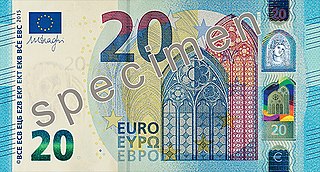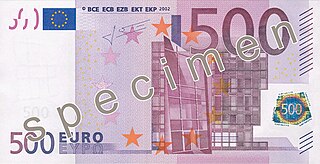
The euro is the official currency of 20 of the 27 member states of the European Union. This group of states is officially known as the euro area or, more commonly, the eurozone. The euro is divided into 100 euro cents.

In economics, cash is money in the physical form of currency, such as banknotes and coins.

The Deutsche Mark, abbreviated "DM" or "D-Mark" ( ), was the official currency of West Germany from 1948 until 1990 and later the unified Germany from 1990 until the adoption of the euro in 2002. In English, it was typically called the "Deutschmark". One Deutsche Mark was divided into 100 pfennigs.

The króna or krona is the currency of Iceland. One króna was formerly divided into 100 eyrir.

Legal tender is a form of money that courts of law are required to recognize as satisfactory payment for any monetary debt. Each jurisdiction determines what is legal tender, but essentially it is anything which when offered ("tendered") in payment of a debt extinguishes the debt. There is no obligation on the creditor to accept the tendered payment, but the act of tendering the payment in legal tender discharges the debt.

The lev is the currency of Bulgaria. In old Bulgarian, the word "lev" meant "lion"; the word "lion" in the modern language is lаv. The lev is divided in 100 stotinki. Stotinka in Bulgarian means "a hundredth" and in fact is a translation of the French term "centime." Grammatically, the word "stotinka" comes from the word "sto".

Currency bill tracking is the process of tracking the movements of banknotes, similar to how ornithologists track migrations of birds by ringing them. It is usually facilitated by any one of a number of websites set up for the purpose, which can track currency among the users of that website. A user may register a bill by entering its serial number, and if someone else has already registered the bill, then the "route" of the bill can be displayed.

The EURion constellation is a pattern of symbols incorporated into a number of secure documents such as banknotes, cheques, and ownership title certificates designs worldwide since about 1996. It is added to help imaging software detect the presence of such a document in a digital image. Such software can then block the user from reproducing banknotes to prevent counterfeiting using colour photocopiers.
Where's Willy? is a website that tracks Canadian paper money, most commonly $5 bills, but also higher denominations. "Where's Willy" is free, supported by users who pay a fee for extra features. The name Willy refers to Sir Wilfrid Laurier - the seventh Prime Minister of Canada whose portrait appears on the $5 banknote.
The Luxembourg franc (F or ISO LUF, Luxembourgish: Frang), subdivided into 100 centimes, was the currency of Luxembourg between 1854 and 2002, except from 1941 to 1944. From 1944 to 2002, its value was equal to that of the Belgian franc. The franc remained in circulation until 2002, when it was replaced by the euro.

Most banknotes have traces of cocaine on them; this has been confirmed by studies done in several countries. In 1994, the U.S. 9th Circuit Court of Appeals cited findings that in Los Angeles, three out of four banknotes were tainted by cocaine or another illicit drug.

Where's George? is a website that tracks the natural geographic circulation of American paper money. Its popularity has led to the establishment of a number of other currency tracking websites and sites that track other objects, such as used books. Statistics generated by the website have been used in at least one research paper to study patterns of human travel in the United States.

Banknotes of the euro, the common currency of the eurozone, have been in circulation since the first series was issued in 2002. They are issued by the national central banks of the Eurosystem or the European Central Bank. The euro was established in 1999, but "for the first three years it was an invisible currency, used for accounting purposes only, e.g. in electronic payments". In 2002, notes and coins began to circulate. The euro rapidly took over from the former national currencies and slowly expanded around the European Union.

The five-euro note (€5) is the lowest value euro banknote. It has been used since the introduction of the euro in 2002. The note is used in the 25 countries that have it as their sole currency, which countries have a total population of about 343 million currently. In July 2024, there were approximately 2,211,000,000 five-euro banknotes in circulation around the eurozone. It is the fifth-most widely circulated denomination, accounting for 7.2% of the total banknotes. Estimates suggest that the average life of a five-euro banknote is less than a year before it is replaced due to wear.

The ten euro note (10 €) is the second-lowest value euro banknote and has been used since the introduction of the euro in 2002. The note is used in the 25 countries which have it as their sole currency ; with a population of about 343 million. In July 2024, there were approximately 3 055 000 000 ten euro banknotes in circulation around the eurozone. It is the fourth most widely circulated denomination, accounting for 10.2% of the total banknotes. Estimates suggest that the average life of a ten euro banknote is about 1.5 years before it is replaced due to wear.

The twenty euro note (€20) is the third-lowest value euro banknote and has been used since the introduction of the euro in 2002. The note is used by the 25 countries and a population of 343 million as their sole currency, with 23 legally adopting it. In July 2024, there were approximately 4,818,000,000 twenty euro banknotes in circulation around the eurozone. It is the second most widely circulated denomination, accounting for 16.3% of the total banknotes. Estimates suggest that the average life of a twenty euro banknote is about two years before it is replaced due to wear.

The fifty euro note (€50) is one of the middle value euro banknotes and has been used since the introduction of the euro in 2002. The note is used by some 343 million Europeans and in the 25 countries which have the euro as their sole currency. In July 2024, there were about 14,712,000,000 fifty euro banknotes in circulation in the eurozone. It is by far the most widely circulated denomination, accounting for almost half (49.0%) of the total banknotes. Estimates suggest that the average life of a fifty euro banknote is about four years before it is replaced due to wear.

The one hundred euro note (100 €) is one of the higher value euro banknotes and has been used since the introduction of the euro in 2002. The note is used daily by some 343 million Europeans and in the 25 countries which have it as their sole currency. In July 2024, there were approximately 3 987 000 000 hundred euro banknotes in circulation in the eurozone. It is the third most widely circulated denomination, accounting for 13.3% of the total banknotes.

The two hundred euro note (200 €) is the second highest value euro banknote and has been used since the introduction of the euro in 2002. The note is used in the 26 countries that have the euro as their sole currency ; with a population of about 343 million. In July 2023, there were approximately 849 000 000 banknotes of 200 € in circulation around the eurozone. It is the second least widely circulated denomination, accounting for 2.9% of the total banknotes.

The five-hundred-euro note (500 €) is the highest-value euro banknote; it was produced between the introduction of the euro in 2002 until 2019. Since 27 April 2019, the banknote has no longer been issued by central banks in the euro area, but it continues to be legal tender and can be used as a means of payment. It is one of the highest-value circulating banknotes in the world, worth around 549 USD; 3 851 CNY; 81 417 JPY; 418 GBP, or 471 CHF as of October 2024. The note is used in the 26 countries that have the euro as their sole currency, with a population of about 343 million.


















